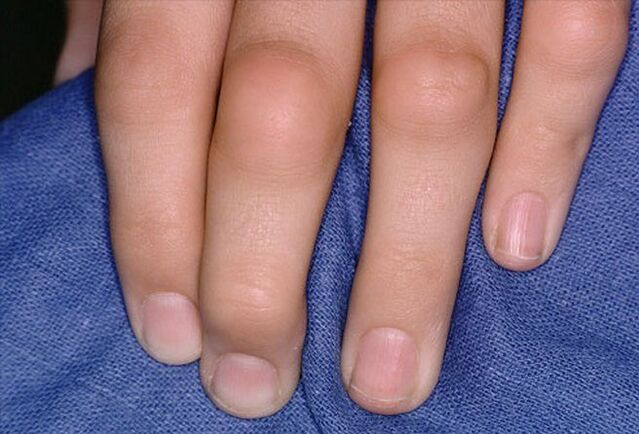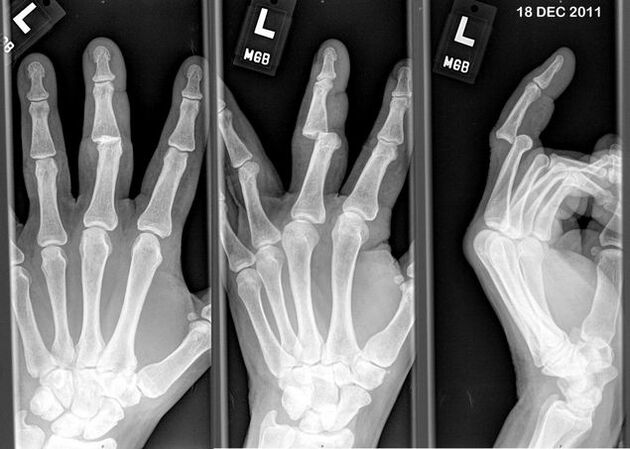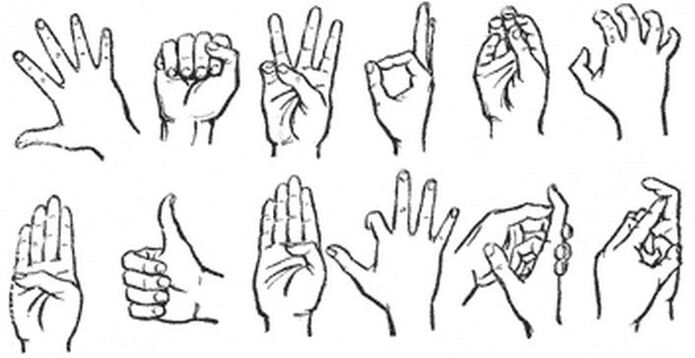
In older age groups, finger pain is very common in both men and women. They are often associated with swelling, stiffness, and creaking when joints are bent or stretched. Such symptoms are not only a sign of natural aging of the body, but also clinical manifestations of various pathologies. Therefore, the cause of pain in the finger joints should be determined and treatment should be carried out immediately.
Causes of pain in the finger joints
If pain occurs every week, after a long manual labor it can no longer be attributed to increased muscle tension. In this way, at the initial stage of development, inflammatory or degenerative-dystrophic pathologies are manifested. Pain in the fingers is associated with the gradual destruction of bone and cartilage tissue, which can lead to deformation of the joints, complete or partial immobilization (ankylosis).

arthritis
The joints of the fingers on the hands can be affected by rheumatoid, reactive, psoriatic arthritis - inflammatory, rapidly progressing pathologies. In addition to severe pain, inflammation is observed - reddening of the skin and swelling, restriction of the range of motion. And the course of infectious arthritis is often accompanied by signs of general intoxication of the body - an increase in body temperature, chills, fever.
Still disease
This is a severe autoimmune pathology, believed to develop due to an insufficient response of the immune system to the introduction of pathogenic microorganisms. Still's disease affects not only small and large joints. The skin, the organs of the cardiovascular and respiratory systems and the lymph nodes are damaged.

arthrosis
This pathology is characterized by the destruction of bone tissue with further deformation of the joints. With osteoarthritis in the morning, the fingers swell and there is some resistance when you try to bend or straighten them. Sharp pain occurs only during relapse and at the stage of remission - only mild discomfort.

Stenosing ligamentitis
The pathology develops due to repetitive monotonous movements. Stenosing ligamentitis affects the ligament-tendon apparatus of the hand, where the finger is blocked in an extended or flexed position. However, such a pronounced symptom appears at the end stage of the pathology, and at the initial stage it is expressed in pain, crunching or clicks when bending the joints.
gout
In gout, crystals of uric acid salts begin to deposit in the finger joints, causing irritation of the soft, cartilaginous bone tissue. An inflammatory process develops, in which ligaments, muscles and tendons are gradually involved. Sharp, burning, throbbing pain occurs during an attack of gout. The skin over the joints swells, turns red, and feels hot.
Polyosteoarthritis
Polyosteoarthritis is a form of osteoarthritis that affects several joints at the same time. Cartilage tissue becomes thinner, thickened and loses its cushioning properties. To stabilize the joints, the bone structures begin to deform and grow with the formation of osteophytes. These growths damage the soft tissues, which often leads to the development of an inflammatory process.
injury
Finger joint pain can be a result of fractures, dislocations, subluxations, ruptures of muscles, ligaments and tendons. A person suffers such injuries if they fall on a straight arm, a high directional impact, or a bruise. If the victim does not seek medical help, the joint structures merge in the wrong anatomical position, so the pain in the hands becomes constant, increases after hypothermia or severe weather changes.

Vibration sickness
This pathology develops in mechanized workers associated with the use of percussion or rotary instruments. Clinically, vibration sickness manifests itself not only in unpleasant sensations in the joints of the fingers of the hands, but also in vascular disorders, angiospasms, circulatory disorders and blood pressure surges.

Tunnel syndrome
The cause of the appearance of tunnel syndrome is a pathology that leads to a decrease in the volume of the carpal tunnel (osteoarthritis, arthritis, lipoma). The result is a compression ischemic lesion of the median nerve. Pain occurs, sensitivity decreases, patients complain to the doctor about numbness, tingling and crawling. Any movement of the hand comes with weakness, especially when you have to grab an object with your thumb.
Symptoms
Jerking, throbbing, sharp pain in the finger joint is the main symptom of gouty, infectious, rheumatoid arthritis, including adolescent. Accompanying symptoms are a rise in the local temperature, reddening and swelling of the skin.
Osteoarthritis and other degenerative-dystrophic pathologies at the initial stage of development are asymptomatic. Occasionally there is slight pain that disappears after a short break. But their severity is constantly increasing. The pain is accompanied by stiffness, clicks when bending and / or extending the fingers.

Effects
Without medical intervention, the intensity of pain increases against the background of deformation of the interphalangeal joints. In the final stages of pathology, there is partial or complete fusion of the joint space. A person is unable to flex or loosen fingers, resulting in loss of work ability and disability.
Inflammatory and destructive processes gradually spread to healthy soft, cartilage and bone tissues. Therefore, pain in several joints or fingers can soon occur.
diagnosis
The primary diagnosis is based on an external examination, patient complaints, medical history data, and the results of a number of functional tests. X-ray, MRI, CT, and arthroscopic examinations are performed to confirm. If an infectious origin of the pathology is suspected, a biological sample is inoculated into nutrient media to determine the type of bacteria and their antibiotic resistance.
treatment
When determining the therapeutic tactics, the doctor (orthopedist, rheumatologist, traumatologist) takes into account the type of disease, the form of its course, the degree of tissue damage and the number of complications that have arisen. To reduce the severity of the patient's pain, the use of soft bandages, splints, or semi-rigid, rigid orthotics is often recommended.
Medication
In the treatment of pathologies manifested by pain in the wrists, drugs of various clinical and pharmacological groups are used. These are nonsteroidal anti-inflammatory drugs (NSAIDs), muscle relaxants, glucocorticosteroids, and chondroprotectors. Medicines to improve blood circulation, B vitamins and warming ointments are also used. Intramuscular and sometimes intra-articular administration of drugs is practiced to alleviate acute pain. The use of tablets or ointments allows you to get rid of less pronounced ailments.
massage
After relieving acute pain and inflammation, patients are assigned sessions of classical, acupressure, vacuum, including hardware massage. Revitalization procedures help improve blood circulation, eliminate muscle spasms, and accelerate the recovery of damaged tissues.
physical therapy
The procedures of electrophoresis, ultraphonophoresis help relieve pain or get rid of it completely. During their implementation, hormonal agents, chondroprotectors, anesthetics, analgesics and group B vitamins are used. For the treatment of joint pathologies, patients can also be prescribed up to 10 sessions of magnetotherapy, laser therapy, and UHF therapy.
Sports exercise
Regular exercise therapy can quickly strengthen the hand muscles, prevent the progression of osteoarthritis or arthritis. The exercises are created by the physician for exercise therapy, taking into account the nature of the disease. It usually includes hand rotations, flexion-extension of the fingers, grasping and holding small objects.

diet
The diet of a patient with arthritis or osteoarthritis should be high in fresh herbs, vegetables, and fruits. Semi-finished products, smoked meat, fast food, fatty meat and any alcohol must be completely excluded from the daily menu. Instead, it is useful to eat rabbit meat, beef, fatty sea fish, clear soups, cereals, and dairy products.
Home remedies
After the main treatment, the elimination of pain and inflammation, doctors may approve the use of traditional medicines. During the rehabilitation period, the use of certain decoctions, hand baths and homemade ointments is allowed.

The use of infusions and decoctions of herbs
Often the course of pathologies provoking pain in the fingers is aggravated by a deterioration in a person's psychoemotional state. Using herbal teas will help improve it. St. John's wort, valerian, feverfew, thyme, lemon balm, oregano have a tonic, calming and sleep-normalizing effect. To prepare a drink, a teaspoon of dry plant material (without a slide) is brewed with a glass of boiling water. Let it steep for a few hours, then filter and take 100 ml before going to bed.
Baked onion and wax ointment
Two peeled medium-sized onions are baked until tender, ground until smooth in a mortar and added in portions to 20 g of melted wax in a water bath. The resulting mass is applied to the joints and fixed with a gauze bandage. The duration of the treatment process is 1-2 hours.
Honey mustard ointment with herbs
Pour a tablespoon of dried flowers of calendula and chamomile into a container, pour 0. 5 cups of boiling water and leave for 5 hours. Mix a teaspoon of dry mustard and fatty sour cream in a mortar and add 2 tablespoons of honey. The resulting infusion is injected drop by drop until a homogeneous mass is formed. Before using the ointment, the skin is lubricated with vegetable oil.
Herbal baths
Put 5 berries with rose hips, juniper, barberry, a tablespoon of elecampane, St. John's wort and birch buds in a thermos. Pour a liter of boiling water and leave for 2 hours. Let cool slightly, filter, pour into a cup and add more warm water if necessary. Soak the brushes in the resulting infusion for 30 minutes.
Oil baths
Fill a small container with warm water (1. 5-2 liters) and add 1-2 drops of essential oils from rosemary, eucalyptus and pine. Pour in a tablespoon of cosmetic almond oil, shake. They put their hands in the water for 30-40 minutes. After the procedure, any nourishing or moisturizing cream is rubbed into the skin.
Straw bowls
Pour 0. 5 liters of chopped oat straw into a small saucepan and 2 liters of hot water. Bring to a boil, simmer over low heat for 30-40 minutes. Let cool to room temperature, filter. Pour the warm broth into a cup and leave the brushes in it for about half an hour.
Preventive measures
To avoid pain in the finger joints, you should undergo a full physical exam every 6-12 months. The pathology established at the initial stage of development usually responds well to conservative treatment. You must also avoid traumatic situations, refrain from smoking, limit alcohol consumption, exclude high-fat foods and simple carbohydrates from the diet.


































